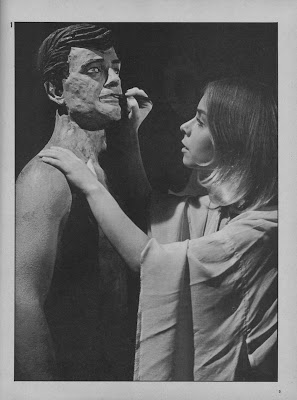 SPAWN star Michael Jai White co-wrote and stars in BLACK DYNAMITE, just out on DVD and Blu-ray, an inspired parody of 1970s blaxploitation pictures that is nearly pitch-perfect in its attention to B-movie detail (or should that be attention to the frequent inattention by the often sloppy filmmakers who worked with low budgets and strict genre conventions).
SPAWN star Michael Jai White co-wrote and stars in BLACK DYNAMITE, just out on DVD and Blu-ray, an inspired parody of 1970s blaxploitation pictures that is nearly pitch-perfect in its attention to B-movie detail (or should that be attention to the frequent inattention by the often sloppy filmmakers who worked with low budgets and strict genre conventions). The genre has been spoofed before, most notably in I’M GONNA GET YOU, SUCKA and UNDERCOVER BROTHER, both funny movies, but BLACK DYNAMITE goes even further in its slavish devotion to duplicating the look, the style, the outrageous plotting, and the sheer nerve of blaxploitation’s wildest endeavors. Director Scott Sanders (THICK AS THIEVES) even goes so far as to duplicate ‘70s-style smog over the Los Angeles skyline.
Plotting is predictably and hilariously all over the map. Suffice to say that Black Dynamite (White as Jim Brown, basically)—pimp, Vietnam vet, ex-CIA—gets violently involved when his younger brother Jimmy is murdered by mobsters. Teaming up with a beautiful neighborhood organizer (Salli Richardson, looking a lot like Pam Grier), black militants led by Phil Morris (MISSION: IMPOSSIBLE), and co-writer Byron Minns in a funny takeoff on Rudy Ray Moore, Black Dynamite bitchslaps all the pushers, pimps, and white mobsters in the neighborhood, following the trail of corruption all the way to The Man at the top. I wouldn't dream of giving away the surprises in the last half-hour of BLACK DYNAMITE.
Original scoring by Adrian Younge and songs lay the musical backdrop for Sanders’ delirously funny film, which is securely anchored by the talented White, who’s got the game, the voice, the excellent comic timing, and the kung fu skills to pull off this perfect parody. He really gets this character. One of my favorite gags is nearly imperceptible, during a righteous monologue by White where the boom microphone pops down into the frame, and the actor—just for a second—glances at it, as if to say, “Brutha, what is this shit?”
The game supporting cast includes Mike Starr, Arsenio Hall, Mikelti Williamson (currently on 24), John Salley, Bokeen Woodbine, Tommy Davidson, Richard Edson, Kevin Chapman, Buddy Lewis, Kym Whitley, Roger Yuen, Obba Babatunde, Miguel Nunez, Irwin Keyes, John Kerry, Tucker Smallwood, Nicole Ari Parker, Nicole Sullivan, and James McManus as The Man. I really want to see a BLACK DYNAMITE 2.









